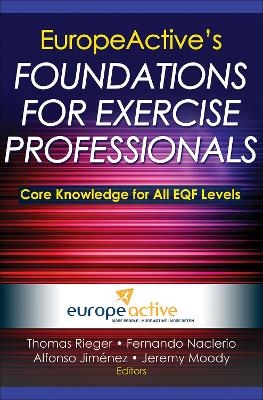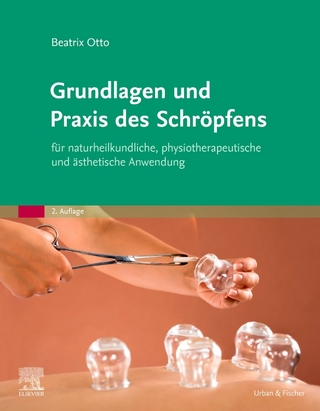
EuropeActive's Foundations for Exercise Professionals
Human Kinetics (Verlag)
978-1-4504-2377-9 (ISBN)
EuropeActive’s Foundations for Exercise Professionals provides core knowledge and industry standards to help exercise professionals serve their clients. Endorsed by EuropeActive, the continent’s leading standard-setting organisation in fitness and health, this text is an authoritative guide for current and future exercise professionals and training providers in Europe.
The book uses scientific foundations to cover concepts and hands-on skills that promote best practices in exercise instruction and training. The content applies to all levels of the European Qualifications Framework (EQF) and associated job titles—the only resource to do so—and matches the core information for EQF levels 3 and 4. Thus, this instructional guide ensures smooth movement and work transfers among employers, educational institutions and countries in Europe.
Written by renowned experts in exercise and sport sciences and framed in the European Register of Exercise Professionals’ Code of Ethical Practice for exercise professionals, the text offers several practical features for readers:
Easy-to-apply instruction accompanied by 88 full-colour photos and 68 illustrations offer an ideal visual learning experience.
Complete descriptions and images detail proper form for common free-weight and machine-resistance training exercises.
Explanations and recommendations are included for the most popular cardiorespiratory exercise equipment.
Official nutrition recommendations prepare professionals to address clients’ concerns.
The complete Code of Ethical Practice serves as a guide for all exercise professionals in Europe.
EuropeActive’s Foundations for Exercise Professionals begins by covering the bones, joints, muscles and cardiovascular system to ensure a proper understanding of the body’s movement and physiology. Readers then learn the components of exercise theory and prescription, including energy systems; body composition; resistance, aerobic and flexibility training; warm-up and cool-down; and the principle of progression. The book helps professionals become role models in the industry with information on managing lifestyle through physical activity, health, nutrition, hydration and safety. After gaining foundational knowledge, readers will look closer at the role of the exercise professional, starting with building rapport, motivating, screening and assessing clients. The final chapters discuss the basic aspects of training: exercise technique using weight machines, free weights and cardiorespiratory equipment.
Both aspiring and qualified exercise professionals should keep abreast of foundational information about all areas of the health and fitness sector in order to properly serve the industry and their clients. EuropeActive’s Foundations for Exercise Professionals is an ideal reference for promoting physical activity, making lifestyles healthier and guiding clients toward their fitness goals.
About EuropeActive The European Register of Exercise Professionals (EREPS) uses the EuropeActive standards to ensure that exercise professionals are qualified to offer safe and effective fitness programmes to their clients all across Europe. EREPS provides consumers, employers and partners in medical professions with confidence so that registered trainers are competent and work to support its Code of Ethical Practice, which defines the rights and principles of exercise professionals. Referencing the EuropeActive standards to each trainer and being registered mean that they have met the minimum standards of good practice and that they are committed to raising the standards of their skills and professional status through a process of lifelong learning. EREPS is regulated by the EuropeActive Standards Council using the official European Qualifications Framework, which describes the knowledge, skills and competencies exercise professionals need to achieve for registration. About the Editors Thomas Rieger is the chairman of the standards council of EuropeActive. He holds a doctoral degree in social sciences with a specialization in sport science (German PhD equivalent) from the University of Tübingen and a master’s degree in public health. In 2007, he was appointed as a professor of sport management at the Business and Information Technology School (BiTS) in Iserlohn, Germany. At BiTS, he is the vice dean of the bachelor’s programme of sport and event management and the MSc programme of international sport and event management. Previously, Dr. Rieger served as the visiting professor at the Real Madrid Graduate School and the European University Cyprus in Nicosia. Before entering academia in 2006, he gained more than six years of experience in the fitness industry, especially in the fields of fitness marketing and quality management. Fernando Naclerio is the principal lecturer in strength training and sport nutrition and the MSc programme leader of strength and conditioning at the Centre for Sports Science and Human Performance at the University of Greenwich, UK. He is a strength and conditioning coach (CSCS-NSCA) and a certified international society sport nutritionist (CISSN). Dr. Naclerio has more than 30 years of experience as a coach, consultant and academic in many countries in Europe and South America. He has published five books, multiple book chapters and more than 100 scientific papers on training and sport nutrition. Dr. Naclerio’s research is currently focused on the effects of resistance training and nutrition strategies on performance, injury prevention and muscle structure as well as morphology in children, adolescents and older adults. Alfonso Jiménez, PhD, CSCS, NSCA-CPT, FLF, is a professor of exercise and health and the faculty dean of the health, exercise and sport sciences department at European University of Madrid (Spain) and a member of the scientific advisory board of UKActive Research Institute. Dr. Jiménez holds a visiting professorial appointment at Victoria University in Melbourne, Australia, as the international research associate. He is the chair of the Fitness Australia/ISEAL research programme and scientific advisory committee at the University of Greenwich in London. During the time that he was head of school and deputy dean at Victoria University, Dr. Jiménezz served as a professor and head of the Centre for Sports Sciences and Human Performance at the University of Greenwich. From 2009 to 2012, Professor Jiménez was the chairman of the standards council of EuropeActive, which at the time was called the European Health & Fitness Association. He was awarded honorary membership in recognition of his outstanding service. Dr. Jiménez’s background before entering academia centred on the fitness industry in management, research and sales. Jeremy Moody is the MSc programme director for strength and conditioning at Cardiff Metropolitan University in Wales, UK, and a frequent national and international speaker in the fields of strength and conditioning and elite sport performance management. Dr. Moody’s experience extends across many able-bodied and disabled sports, and he has worked with many successful athletes at the Commonwealth, European, World, Olympic and Paralympic levels of competition as well as with many youth and developing athletes. Previously, he was the performance director for Great Britain Wheelchair Rugby and the Welsh Judo Association, a senior performance manager for UK Athletics and a regional lead strength and conditioning coach for the English Institute of Sport.
Chapter 1. Bones and Joints
Marco Branco and Rita Santos-Rocha
Major Bones and Joints
Types of Bones and Joints
Structure and Function of the Skeleton
Structure and Function of the Spine
Movements at the Three Main Spinal Curves
Stability and Movement Within Each Type of Joint
Conclusion
Chapter 2. Muscles
Anders Nedergaard
Skeletal Muscle Biology
Smooth Muscle
Cardiac Muscle
Conclusion
Chapter 3. Muscle Action
Daniel Robbins and Edzard Zeinstra
Types of Muscle Actions
Neuromuscular Physiology
Muscles and Movement
Muscles and Force Generation
Conclusion
Chapter 4. Heart, Lungs and Circulation
Andrea Ermolao and Marco Bergamin
Mechanics of Breathing
Heart and Cardiovascular System
Blood Pressure and the Effects of Exercise
Short and Long Term Effects of Exercise on the Heart, Lungs and Circulatory System
Conclusion
Chapter 5. Energy Systems
Rodrigo Fernandez-Gonzalo, José Antonio de Paz, and Fernando Naclerio
Three Energy Systems That Produce ATP
Oxygen Uptake, VO2max and Excess of Oxygen Uptake
Effects of Intensity and Duration on Energy System and Fuel Interaction During Physical Activity
Conclusion
Chapter 6. Components and Principles of Fitness
Eliseo Iglesias-Soler and Mark Chapman
Physical Fitness and Health-Related Fitness
Relationship Among Physical Activity and Exercise, Health Related Fitness and Health
Conclusion
Chapter 7. Resistance Training
Fernando Naclerio and Jeremy Moody
Muscle Action and Type of Contraction
Muscular Strength and Repetition Maximum Continuum
Overload Principle Applied to Muscular Strength
Common Resistance Training Methods and Systems
Muscle-Group Split Routines
Conclusion
Chapter 8. Aerobic Training
Jonathan Esteve-Lanao, Roberto Cejuela Anta, and Claudia Cardona González Physiological and Health-Related Changes From Aerobic Training
Benefits of Aerobic Training
Continuous and Interval Aerobic Training
Types of Activities in Endurance Training
Overload Principle Applied to Aerobic Training
Application of All Training Principles to Aerobic Training
Methods of Intensity Monitoring
Exercise Session Structure
Cardiorespiratory Training Systems
Periodisation and Training Load Quantification
Conclusion
Chapter 9. Flexibility Training
Jagdeep Singh Matharoo
Range-of-Motion Continuum
Physiological and Health-Related Changes From Stretching
Types of Flexibility Exercises
Methods for Training Flexibility
Stretch Reflex, Desensitisation and Lengthening of Muscle Tissue (Muscle Creep)
FITTA Principle Applied to Stretching
Factors Affecting Potential Range of Motion
Conclusion
Chapter 10. Body Composition
Elvis A. Carnero and Manuel A. Giráldez García
Hierarchical Organisation for the Study of Body Composition
Body-Composition Measurement
BIA and Anthropometry
Factors Affecting Body Composition
Conclusion
Chapter 11. Warm-Up and Cool-Down
Bettina Karsten and Xurxo Dopico
Definition of Warm-Up and Cool-Down
Types of Warm-Ups
Physiological Effects
Duration and Intensity Recommendations
Conclusion
Chapter 12. Progression
Ian Jeffreys
Homeostasis in the Body
General Adaptation Syndrome
Conclusion
Chapter 13. Promoting Physical Activity and Health
Steven Mann and Alfonso Jimenez
Hypertension
Dyslipidemia
Impaired Fasting Glucose
Obesity
Barriers and Motivators for Physical Activity and Exercise
Conclusion
Chapter 14. Basic Nutrition and Hydration Guidelines
Robert Cooper and Judith Allgrove
Macronutrients
Energy Expenditure
Body Composition
Dehydration and Physical Activity
Hydration Strategies
Official Nutrition Recommendations
Conclusion
Chapter 15. Safe and Effective Exercise
Rita Santos-Rocha and Nuno Pimenta
Exercise as Mechanical and Metabolic Stimuli
Risks Associated With Exercise
Preliminary Health Screening and Risk Assessment
Conclusion
Chapter 16. Body Awareness and Exercise Technique
Vera Simões and Rita Santos Rocha
Being a Role Model in Exercise Performance and Technique
Correcting Posture and Body Alignment, Range of Motion, Control, Timing and Form
Conclusion
Chapter 17. Building Rapport and Customer Care
Thomas Rieger
Understanding Intimacy as a Key Requirement
Dimensions of Rapport
Methods of Building Rapport
Conclusion
Chapter 18. Motivating the Exerciser
Jeremy Moody and Jack Davies
Motives to Exercise
Behavioural Strategies to Enhance Exercise and Health Behaviour Change
Transtheoretical Model
Conclusion
Chapter 19. Screening and Assessing
Jeremy Moody and Ryan Stevens
Evaluation of Fitness Components
Screening and Assessing for Medical History
Psychological Aspects of Fitness
Conclusion
Chapter 20. Resistance Exercise Using Machines
Roger Earle
Terms and Definitions
Breathing
Practical Guidelines for Teaching Resistance Training Exercises Using Machines
Technique Guidelines
Additional Machine Exercises
Conclusion
Chapter 21. Resistance Exercise Using Free Weights
Roger Earle
Terms and Definitions
Breathing
Safe and Effective Spotting Techniques
Practical Guidelines for Teaching Resistance Training Exercises Using Free Weights
Technique Guidelines
Additional Free-Weight Exercises
Conclusion
Chapter 22. Cardiorespiratory Exercise
Henk Jan Thoes and Riccardo Marini
Treadmill
Rower
Stepper
Upright Bike
Recumbent Bike
Cross-Trainer
Linear-Stride Cross-Trainer
Variable-Stride Cross-Trainer
Lateral-Movement Cross-Trainer
Upper-Body Ergometer
Conclusion
| Verlagsort | Champaign, IL |
|---|---|
| Sprache | englisch |
| Maße | 178 x 254 mm |
| Gewicht | 907 g |
| Themenwelt | Sachbuch/Ratgeber ► Gesundheit / Leben / Psychologie |
| Sachbuch/Ratgeber ► Sport | |
| ISBN-10 | 1-4504-2377-9 / 1450423779 |
| ISBN-13 | 978-1-4504-2377-9 / 9781450423779 |
| Zustand | Neuware |
| Haben Sie eine Frage zum Produkt? |
aus dem Bereich


